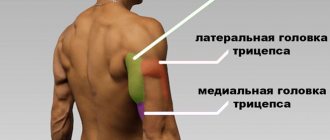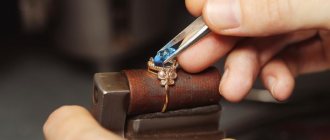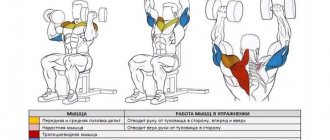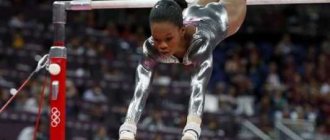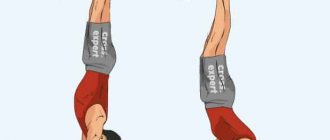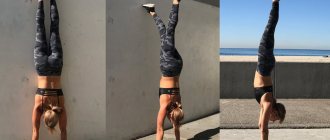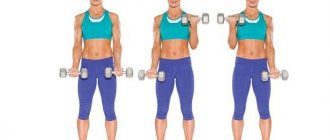Thanks to a strong grip, you can protect yourself from various injuries, get beautiful forearm muscles and get a powerful handshake. Such training is necessary for people involved in mountaineering, arm wrestling, basketball, kiting, bodybuilding and weightlifting.
There is a common belief that grip strength is entirely dependent on the size of the forearms. This statement is only partly true, and a number of specific training methods are used to develop grip, which will be discussed in detail below.
How does grip strength increase?
The biceps are practically not involved in the grip. Its strength increases as a result of active training of the forearms and hands.
Many professionals claim that they were able to develop a strong grip by doing pull-ups on a thick horizontal bar and using a bar with an increased diameter.
To increase your grip strength you must adhere to:
- The principle of progressive loads, which involves a gradual increase in working weights with each workout. To increase strength parameters and muscle growth, it is important to increase the number of repetitions and approaches.
- The principle of periodization allows you to avoid overtraining, which entails a stop in development. Therefore, it is recommended to perform exercises to increase grip strength no more than once every 7-10 days.
- According to the principle of super compensation, training too infrequently has the same negative impact on increasing grip strength as training too often. In case of loss of super compensation, the strength parameters of the hand return to pre-training indicators.
To increase such strength, it is important for the body to maintain a balance of serotonin, dopamine and testosterone. Excessive amounts of cortisol (a female hormone) greatly inhibit muscle growth. Overeating significantly reduces the production of growth hormone, so you should be very careful about the task of creating your own diet.
What muscles work in pull-ups?
Pull-ups combine strength and functional load, since they involve several muscle groups at the same time. The correct technique of this exercise involves synergistic work of the muscles of the shoulder girdle, back, abdomen, and chest. “During a pull-up, different muscle groups are involved in the work - the muscles of the back, deltas, biceps and triceps,” explains Ilya Frank, expert and coordinator of the X-Fit combat sports department in Russia. “Each muscle group is the main one in a certain movement (at the moment of the positive and negative phases of muscle contractions, which are in the pull-up).”
The load is redistributed during movement. The muscles of the back and shoulder girdle as a whole are actively working. While hanging, the back muscles become more tense, and when lifting the body upward, the muscles of the arms and shoulders are activated. The maximum voltage phase is at the moment when the body is at the top point. “The main muscles involved in the work when doing pull-ups: latissimus, teres dorsi, rhomboid, serratus anterior, rear deltoid, biceps,” explains Alexey Bolyaev, personal trainer at the Women Secrets women’s fitness studio in Tsaritsyno .
The pectoral muscles and abs are also involved in pulling up - they help stabilize the position of the body.
Grip strength training
It is recommended to perform exercises aimed at strengthening your grip at an average pace without haste. There is no need to do long intervals. Better results can be achieved by combining exercises to develop pinch strength, holding strength and compressive ability into a single complex. Before you begin performing such exercises, you need to properly stretch the tendons, ligaments and muscles of the forearm. It is best to forget about wrist belts forever, and in the gym you should pay more attention to free weights than to block exercise machines.
Exercises to strengthen the hands[edit | edit code]
Static grip[edit | edit code]
If we pull a lot of weight (for example, we do deadlifts, block pulls, etc.) or hang from a bar, we use our hands as hooks. The weight has to be held with only four fingers, and the thumb has no use. In this grip, the forearm muscles work only statically.
Exercises
The most effective exercise for developing static grip is the so-called “farmer's walk”. You take a heavy dumbbell in each hand and walk a certain distance with them. From 5 meters onwards. You can hold them while standing still, but this is more tiring for the psyche.
Dynamic grip[edit | edit code]
The entire range of actions, from shaking hands to wringing out a T-shirt soaked in sweat from training, can be classified as dynamic grip. Usually four fingers take the force, and the thumb protects against the object slipping or falling out of the hands.
Exercises
.
In this regard, nothing can be better than the good old hand expander. One of its best variants is called "Captain of Crush". It simply looks like two handles connected by a steel spring. The highest efficiency of such a simple design has been tested by time. There are also exercise machines with adjustable loads that use both hands at once. Example: Hammer Gripper. And, of course, don’t forget about a simple rubber “ring” or a tennis ball. Although they do not have such loud and beautiful names, they can easily give odds to famous simulators...
Finger grip[edit | edit code]
Holding a glass of water or any other object of sufficiently large diameter or size with your hand is a finger grip. In most cases it is only static. We use this grip when the shape of the object does not allow it to be pressed against the palm with four fingers, so the thumb has to take the lion's share of the load.
Exercises
.
The most famous and probably the most effective exercise is holding a plate off the barbell with your fingers. Choose a heavy pancake, place it on its edge, grab the top edge tightly and lift it low above the floor. Hold for approximately 30-60 seconds. When you can hold it for a longer time, then it’s time to take a larger and heavier pancake...
There are other techniques for developing a finger grip, but they, as a rule, require additional equipment (homemade), and are in no way superior in effectiveness to the method of holding a pancake mentioned above.
Wrist strength. Dynamics[edit | edit code]
Our wrists are very fragile joints. And this is an additional reason for their conscious strengthening. At the same time, the development of the dynamic functions of the forearm will lead to its growth, and with large muscles it is much easier to become strong than with small ones... Moreover, along with muscle growth, tendons, ligaments are strengthened and even the strength of bones increases. Not a bad prospect for a weak joint, right?
Exercises
.
It’s easy to guess that the most effective movements for developing the wrist flexor-extensor muscles are these same flexions and extensions with weights in the hands. Moreover, if in flexions (lifting the barbell with your hands, palms facing you) only 4 fingers work, and even then not very much, with extensions (lifting the barbell with your hands, palms away from you) the situation is completely different. The exercise uses the thumb as much as possible, and the other 4 insure the barbell from falling out. This feature allows you to very successfully develop both wrist extensors and finger grip strength!
Typically, the starting position for these exercises is to place your forearms on a bench with only your hands hanging over the edge. But there may be variations, such as bending your wrists behind your back or extending them in front of you with your arms vertical. No one can tell you whether this or that type of exercise will work for you. You yourself must try, think, “try on” the movement and make your choice.
Powerful compressive ability
A striking example of a strong squeezing ability is the handshake, which is called the “iron” handshake. The simplest and most accessible way to develop this strength are hand expanders and special rings made of rubber. First, it is best to take an expander or ring that allows you to perform no more than 7-10 compressions in one approach. You should switch to a harder expander after 3-4 weeks of regular exercise.
Compressive force also includes chopping wood with an axe. The constant change in the position of the center of gravity, the presence of acceleration and the moment of impact contact with a strong tree give the muscles of the forearm and hand a significant load.
There is another noteworthy way to develop compressive ability, which is to lift weights using ordinary forceps. John Brookfield describes it in one of his books, and it looks something like this:
- A durable metal bucket is filled with a weighting agent at the athlete's discretion (wet sand, nails, stones or any other filler).
- The handle of the bucket is wrapped with a rope or strap. Otherwise, the weight may slip out of the tongs and cause injury.
- It is necessary to lift the bucket using tongs so that they are in a vertical position.
Everyone should calculate the weight of the weighting material, the number of approaches and repetitions for themselves experimentally. The main thing is not to overdo it with weight at the initial stage of training, however, training with too light an apparatus will also not bring positive results. This exercise is more suitable for athletes living in their own homes rather than in apartments. City dwellers can be advised to use the following alternative: taking an ordinary broom by the very tip of its handle, you need to lift it from the floor with one hand. When the exercise seems too easy, you should add a weighting agent in the form of a brick to the opposite end of the tool.
Comprehensive program
The forearm grip needs to be trained like other parts of the body. This is true in terms of number of sets with repetitions of exercises, as well as intensity with training frequency and rest time.
However, the sensations will be completely different. When training the forearm, the athlete does not feel pain or fatigue. The main thing is not to overdo it.
When the intensity in the program is set to 80% of a single maximum, this means for you that you need to perform 5 to 8 repetitions with a certain weight. As for static exercises, keep the weight to 10 counts, this will correspond to 100%.
Holding force
The holding force has the closest relationship with powerful compressive ability, so they must be developed synchronously. To train holding power, it is recommended to use thick dumbbell handles and a bar, which will complicate the work, but will allow you to work your forearms much more effectively and strengthen your hands. One of the most effective exercises for developing holding strength is the Farmer's Walk. It is performed in a very simple way: taking heavy dumbbells in your hands, you just need to walk around with them. It is necessary to walk until a slight burning sensation appears in the forearms.
It is preferable to do the exercise at intervals of 5-6 days.
Another interesting idea is hanging on a horizontal bar, during which the weight is held using four fingers (the thumb does not take part in this exercise). Some athletes wrap a towel around the barbell or dumbbell to develop holding strength. Such tactics have a certain effectiveness, but are traumatic. Today, there are special attachments on the neck designed to expand its diameter.
Age-related features of the development of fine motor skills of the hands
Arkhipova E.F. Doctor of Pedagogical Sciences, Professor at Moscow State Pedagogical University, Moscow.
Age-related features of the development of fine motor skills of the hands and hand-eye coordination of a child from birth have been studied and described.
After the baby , up to two to three months, the baby's hands can be clenched into a fist, but the thumb should normally be on top, and not inside the fist.
Then, after three months, the fists “open” and the child’s straightened hands begin to pat around themselves, grabbing what adults put into the child’s hands. Then the child's hand begins to reach out to what the eyes see.
After five months, the baby develops a “pincer grip,” where the thumb and index finger stand out. The child's two fingers are parallel, and then the child begins to reach out and grab small objects. Reaches for strings and pays attention to small objects.
Between three and six months , the baby actively moves his hands toward his mouth. Monitors hand movements. Under visual control, he directs his hand towards an object and grasps it.
After six months, the baby develops a “pinching grip.” The child’s fingers, thumb and index, are not connected in parallel, but in a rounded manner. And then there comes a period when the child trains in a pinch grip.
By ten months , the child should develop the “pointing gesture,” but this gesture and the separation of the index finger separately must be taught to the child. A “single” field of vision and action develops. The child's eyes guide the movement of the hand. Children transfer an object from one hand to another, they can put a spoon in a cup, cubes in a box.
There is scientific research data that predicts that if a child has gone through such a path in the development of fine motor skills of the hand until the end of the first year of life, then the brain structures all develop according to ontogenesis, that is, according to the norm.
Both hands of a child under two years of age work equally. Only towards the end of the second year of life does the leading hand begin to be determined.
In the period from one to two years, the child can draw strokes and “doodles”, can hold a cup well, lift it and drink independently. Correlates and places the square in the square slot, and lowers the oval into the oval hole. Can repeat images of several horizontal, vertical and rounded lines. Can hold two objects in one hand at once, draw with a pencil, turn the pages of a book, stack from two to six cubes on top of each other.
Between two and three years of age, a child can turn on musical toys, turn a phone dial with his finger, draw lines, reproduce simple shapes, cut with a plastic knife, and draw a cross according to a pattern. They open drawers and boxes with great interest and tip over their contents. They love to play with sand and clay. They can open screw caps, try using scissors, paint with their fingers, string beads and others.
In the period from three to four years, a child can trace along contours and copy some geometric shapes. Dexterity in the hands appears and the child can grab a ball rolling towards him. The child should hold the pencil correctly with three fingers, and not with a palm grip. He tries to copy shapes with several features and assemble buildings from nine cubes. Can draw not only with pencils, but also with colored crayons. The child can fold a square piece of paper more than once.
Between four and five years of age, a child can color simple shapes, copy capital block letters, and draw a person, depicting two to three parts of his body. Tries to copy square, star and other shapes. A complex cortical brain function “stereognosis” is formed and the child can identify objects by shape, size, texture in the bag by touch, without visual control. The child shows interest in modeling from plasticine and completes tasks according to the model. Masters self-care skills: buttons and unbuttons buttons, opens and closes zippers, unties a scarf, laces shoes, etc. All this is possible only with the correct development of fine motor skills of the fingers.
Between the ages of five and six, a child can carefully cut out pictures and write letters and numbers. Willingly adds missing details to the picture. Can deftly hit a nail with a hammer. Can easily reproduce geometric shapes based on a model.
The age of six to seven years is a sensitive period for the development of fine hand movements necessary for mastering grapho-motor skills for writing. At this age, by organizing various types of activities and systematically using training exercises, you can achieve good results in the development of hand motor skills, form grapho-motor skills and prepare the hand for writing at school.
Features of fine motor skills of children with speech disorders
Research results by N.S. Zhukova, M.M. Koltsova, E.M. Mastyukova, T.B. Filicheva confirms that training fine movements of the fingers stimulates speech development.
Children with speech impairments rarely have confident coordination of finger movements. As a rule, they experience motor clumsiness, imprecision of movements, difficulties in mastering the motor program and switching, and synkinesis (cooperative movements of other parts of the body).
Back in the middle of the last century, it was found that the level of development of children’s speech directly depends on the formation of fine movements of the fingers. If the development of movements corresponds to age, then speech development is within normal limits. If the development of finger movements lags behind, then speech development is delayed or distorted.
Research conducted by M.M. Koltsova, proved that finger movements stimulate the development of the central nervous system and accelerate the development of a child’s speech. Her research confirmed that about a third of the total area of the motor projection of the brain is occupied by the projection of the hand, which is located next to the projection of the speech motor area. And systematic work on the movements of the fingers really stimulates the maturation of the central nervous system, which manifests itself, in particular, in accelerating the development of the child’s speech.
Thus, finger gymnastics stimulates the areas of the cerebral cortex responsible for fine motor skills and speech.
This provision explains the recommendations of scientists to include in the preschool education system activities aimed at developing fine motor skills of the fingers.
Children with speech disorders acquire self-care skills late and with difficulty. Most children cannot button a button, untie a scarf, or perform other self-care tasks.
During drawing classes, they don’t hold a pencil well and their hands are tense. Many children don't like to draw. Motor clumsiness of the hands is especially noticeable during applique classes and with plasticine.
In works on appliqué, difficulties in the spatial arrangement of elements can also be traced. Violation of fine differentiated movements in the fingers is manifested when performing sample tests of finger gymnastics.
Children find it difficult or simply cannot perform an imitation movement without outside help, for example, “lock” - put their hands together, intertwining their fingers; “rings” - alternately connect the index, middle, ring and little fingers with the thumb and other finger gymnastics exercises.
During origami classes they experience enormous difficulties and cannot perform the simplest movements, since both spatial orientation and subtle differentiated movements of the fingers are required. Many children under five or six years old are not interested in playing with small construction sets, do not know how to play with small toys, and do not assemble puzzles.
Children of older preschool age have difficulties in mastering graphic skills. Some children exhibit “mirror writing of letters.” Many children do not have a finger grip on a pencil or pen. Children still have a tendency to palmally grasp a pencil.
Most children of senior preschool age experience general tension in their fingers and hands when drawing. Because of such tension, the child quickly gets tired, and the lines reflecting this tension become uneven and wavy. The more the child tries, the more the tremor-shaking of the hand will be reflected on the paper.
Many studies confirm that the level of speech development is always directly dependent on the degree of development of fine movements of the fingers.
The famous teacher V.A. Sukhomlinsky argued that “the child’s mind is at his fingertips,” therefore improving children’s fine motor skills contributes to the development of their speech and intelligence.
Aristotle called the hands “The hand is the tool of all tools.” Kant called the hands: “The hand is a kind of external brain.”
The English psychologist D. Selley also attached great importance to the “creative work of hands” for the development of children’s thinking and speech.
Currently, modern scientists have established that the level of development of children's speech is directly dependent on the degree of formation of fine movements of the fingers, and the improvement of speech directly depends on the degree of hand training.
Famous neurologist and psychiatrist V.M. Bekhterev wrote that the function of hand movement is always closely related to the function of speech, and the development of the first contributes to the development of the second.
Even the research of physiologist I.P. Pavlov. showed that speech is, first of all, muscle sensations that come from the speech organs and from finger movements to the cerebral cortex.
If you look at a medical atlas and find a “map” of the brain there, you can see that the motor speech area is located very close to the motor area of the hand. The size of the projection zone of the hand and its proximity to the motor speech zone have led many scientists to believe that training fine movements of the fingers will have a great impact on the development of a child’s active speech.
Interesting observations are noted by researchers studying the motor development of children. If a child is asked to make precise movements, he immediately begins to get tired, distracted and tends to evade the task. The inability to achieve accuracy depends on the underdevelopment of cortical mechanisms and on the lack of development of “formulas” of movement, that is, due to lack of training. The child’s apparent motor activity and tirelessness is associated with the fact that he does not make productive working movements that require precision and, consequently, a large expenditure of energy.
Fine motor skills require coordinated motor activity of the small muscles of the hand and eye. It must be mastered gradually. Fine motor skills help a child explore, compare, and classify the things around him and thereby allow him to better understand the world in which he lives. Fine motor skills help a child take care of himself independently, express himself through play and plastic arts, and provide the opportunity to gain social experience.
A number of studies pay much attention to the question of whether the development of a child’s motor skills is a consequence of the natural maturation of the corresponding structures or is it the result of learning.
The conclusions drawn indicate that both natural maturation and learning are equally significant for the formation of a child’s motor skills. This is especially true for finger motor skills.
Research shows that imitation plays an important role in mastering hand movements. There are three types of imitative reactions: repetition of one’s own movements; repetition of familiar adult movements; repetition of new movements.
According to L. S. Vygotsky, drawing “is a kind of graphic speech, a graphic story about something.” Special studies have shown that there is a kind of critical moment when simple pencil scribbling and meaningless scribbles begin to mean something.
Pinch force
Even in the case of developing powerful compressive and holding power, it is necessary to develop the fingers, especially the thumb, which is practically not used during standard exercises. You can load it well by holding the smooth discs away from the bar. It is best to start with pancakes weighing 5-10 kg. To improve pinch strength, you should also pay attention to the following effective exercises:
- All fingers are threaded through a piece of thick elastic, after which you need to try to straighten them completely.
Having reached the point of maximum tension, you need to hold on to it for as long as possible, without letting your fingers close. I advise you to do this exercise every day. The result will not keep you waiting long. - A rigid expander with metal or wooden handles must be fully squeezed and held in this position for 20-30 seconds using the efforts of the fingers. Performed in 3-4 sets with a single repetition.
- A Yawara, Kubotan, or a regular wooden stick is great for everyday warm-up. For example: resting one end of the projectile on your thumb, you need to alternately and with maximum effort press the pads of your other fingers on the opposite end, holding the static tension for 8-10 seconds. Instead of a stick, you can use a ball made of thick rubber.
Fighting technique
When you go into a fight, the first thing you need to do is take the right stance, and this has its own characteristics. Knowing them will increase your chances of winning against an unprepared opponent.
How to take a proper stance
- With your left hand (provided that the fight is fought on the right), we tightly grasp the pin, which cannot be lowered.
- The athletes' hands are placed so that the grip is exactly in the middle. When grabbing, it is forbidden to cover the opponent's fingers.
- The opponents' shoulders must be parallel to the floor.
- The elbow takes up space on the pad; tearing it off during a fight is prohibited.
- Place your feet in a standing position. Some professional arm wrestlers even rest their feet on the table counter.
F. Emelianenko lost to B. Sapp at an arm wrestling tournament Others
There are two main fighting techniques: using a hook grip and fighting on horseback.
The point of the hook grip is to initially twist the opponent's hand towards you, so that your own palm is facing your face. With this grip, you will fight using the muscles of the biceps and lateral ligaments. Pressure occurs either sideways or diagonally. In this case, the working shoulder is brought forward.
When conducting horse wrestling, you will need to try to increase the length of the lever as much as possible, with which you will put the load on your opponent’s biceps. Therefore, it is necessary to try to grab the opponent’s hand as high as possible.
Brush strength
Sports tricks such as tearing a book or a deck of cards into two parts, as well as straightening nails, tire irons and horseshoes are based on the strength of the hand. An effective exercise for developing this strength is the wrist curl, only the weight used is not dumbbells or a bar, but a disc. There is an option to perform this exercise with a similar grip, only in a standing position. Throughout the entire approach, the hands should remain motionless.
To increase the strength of your hands, exercises that involve holding a rope and winding a cable with weights around a handle are good.
Rotation training
The bulk of Powerball projectiles on the market are made of plastic, but there are metal models designed for advanced athletes.
Powerball is a wrist trainer that works on the gyroscopic principle. That is, the more you spin it, the greater the load will fall on the hand and forearm muscles. There are “balls” with backlight, a spin counter, a speedometer showing the current speed and other useful functions. This projectile allows you to strengthen your fingers, hands and forearms. Another very effective method of such training is dumbbell rotation. To perform the exercise, take a heavy dumbbell in each hand, after which, from a standing position, rotate your wrists back and forth counterclockwise and in the opposite direction.
Efficient technology
The anatomical structure of the forearm is complex. This should be taken into account when creating an individual training program. For a bodybuilder, muscle mass is important.
By training his strength, he will be able to build muscle. Moreover, in a lesson you should limit yourself to 1 or 2 exercises. Otherwise, it will already be endurance training.
With short but intense physical activity, fast-twitch muscle fibers are developed, which have a high growth potential. The ratio between slow fibers and fast fibers can be represented by the proportion: 50:50.
Therefore, the complex should include both grip work and isometric exercises. When you move on to holding heavier weights, make sure you take plenty of time to rest. It is necessary that the muscles have time to recover between workouts.
Benefits of a strong grip
A strong grip is an indicator of good health, and it is not for nothing that during a medical examination in hospitals they still use a dynamometer to this day, which must be pressed with the help of hand strength. It is precisely because of an insufficiently strong grip that many bodybuilders with developed muscles turn out to be weaker than lightweight powerlifters.
The hands have a close connection with the brain, and their development has a beneficial effect on the functioning of neural networks. Its importance in such sports and disciplines as boxing, hockey, tennis, powerlifting, martial arts, workout and crossfit cannot be underestimated.
A strong grip is important not only for full-fledged work in the gym, but also for solving various everyday problems.

